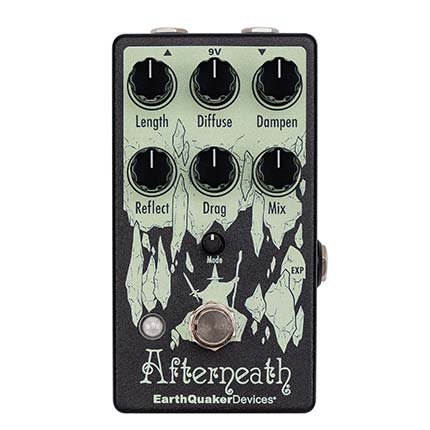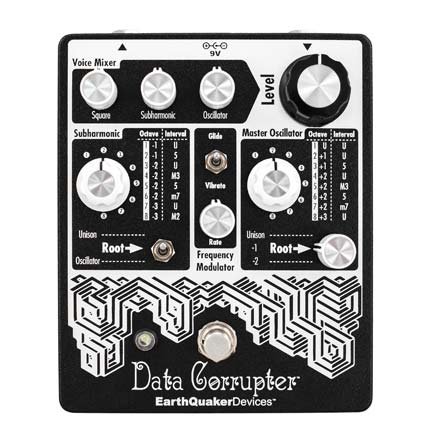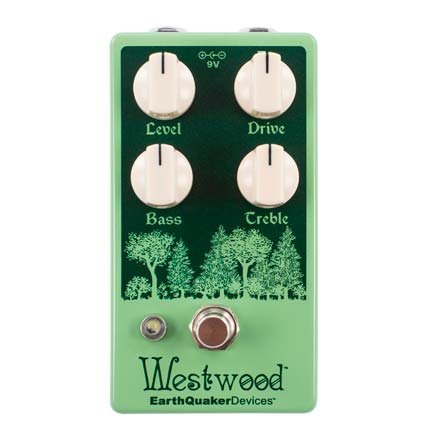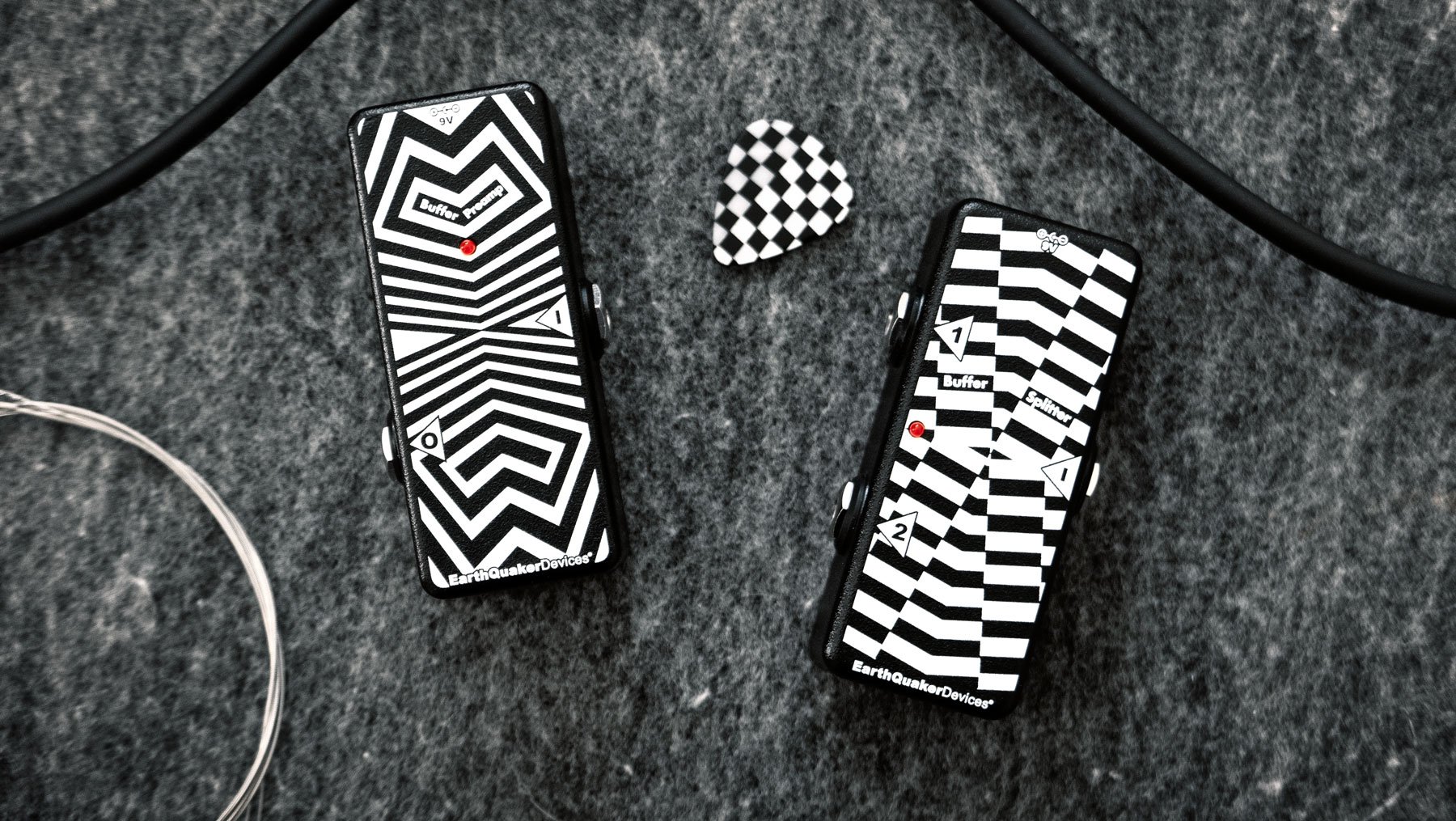Coloration, Inspiration, Disintegration
Jeff Schroeder
MY GENERAL APPROACHES TO USING EFFECTS
I suppose that somewhere deep inside me there is some residual desire for plugging straight into an amplifier (and not a very strong one for plugging straight into a computer, although I do it quite often). Yet, most of the time, whatever desire is left for a purity of sound gets overpowered, outmaneuvered, and plumaged by the ability to almost infinitely play with my guitar tone through using effect pedals, rack units, plug-ins, or just about anything else I can run my guitar signal through.[1] What follows is a brief discussion of the various approaches I take to using guitar effects in three contexts: live, studio, and composition.
In the context of live performance, it usually depends on the material and what amplifier I’m using that will determine what and how many effects I'll be using. In the Smashing Pumpkins I use a Revv Generator 120 amplifier, which is a four channel head with a clean channel and three independent gain channels with a wide variety of tonal shaping options that are MIDI assignable to each individual channel. The amplifier itself provides the core elements of my sound, particularly in terms of distortion, from overdrive to high gain. Within this framework, I am using effects primarily as a way to color and enhance what is already being provided by the amplifier itself. For example, I almost never use an overdrive or distortion pedal into the clean channel of the head to play the heavy songs in our set. However, I do often run my Analogman Beano Boost into channels three or four of the amp for my lead sound. The core of the sound is still the amp but it is now in a conversation with the germanium diodes in the Beano Boost that is quite reactive to the information it’s getting from the guitar in terms of picking dynamics and volume. Chorusing, phasing, flanging, delays, and reverbs are used to provide different aural perspectives of the sound of the amplifier without really losing the core of the sound.
For a live Smashing Pumpkins performance we play material that covers the entire recorded catalog of the band, so I have to be able to create a very wide variety of sounds and textures, which is why I rely on the Line 6 Helix to not only provide the bulk of my effects but also to create and manage my signal flow and send all the MIDI changes to my Revv Generator 120. I don't use any amp modeling live. The Helix is only providing effects. I have been both a user and fan of the Helix since it first appeared in our ever changing and shifting guitar landscape. It sounds fantastic, isn't too difficult to create sounds quickly, and it has an open enough ecosystem to allow me to use other pedals and effects units in conjunction with it when necessary. I often tell people that using the Helix is like having a virtual museum of the last seventy years of guitar effects at your disposal. This is quite necessary for me because we do our best to recreate the sonic spirit of the original recordings when playing the songs live. Hence, I need a lot of different effects, from those classic phased and flanged tones to modulated delays and reverbs. The Helix provides me with the perfect palette of effects to convincingly recreate these sounds.
The second way I approach effects in a live context is when I use an amp as a pedal platform. Someone in the audience will very rarely hear the amp in and of itself. It is almost always being colored by an effect pedal. In much of the music I do outside of the Smashing Pumpkins, I almost never use a straight clean sound. Being a huge admirer of players such as John McGeoch, Keith Levene, and Robert Smith, I like to have some form of modulation and/or chorus on almost all the time. This is also the case for distorted sounds. I’m almost always trying to do something to disfigure the sound. The amp, then, is essentially a blank canvas to color with all sorts of sound shaping devices. In comparison to my approach in the Smashing Pumpkins, where the amp has a very defined characteristic, in this context I almost always want to the amp to be very neutral.[2]
In the studio I take a much different approach to using effects than when playing live. While it might be easier to discuss this topic only in regard to guitar effects, I feel like it wouldn't quite capture how I go about recording and my general creative process. I think of music in terms of feelings and emotions taking place internally and how I might consciously or subconsciously translate them into chords, melodies, guitar parts, or sound. When I begin a new project, such as the one I am just finishing with producer Vice Cooler, I start by trying to think about what it might be that I would like to convey from a thematic perspective, even if it’s very vague at the time. Being a big collector of books, records, films, as well as musical equipment, I begin by curating a pile of books to read, albums to listen to, and films to watch that put me in a mindset I'd like to capture in sound. Then I go about figuring what guitars, amps, and pedals I think would best serve the themes I'd like to explore. All these elements then move into dialogue with each other. I have a pretty large collection of guitars, amps, and pedals and it can be overwhelming (and time consuming) to think about what to use all the time. Once I create a small universe of books, music, guitars, amps, and pedals, I try to put these various elements in conversation with each other and explore the space and textures—both mental and sonic—that are created. For the record with Vice Cooler, we ended up with a pretty stable collection of guitars, amps, and pedals that we used throughout the recording process. For effects, it was a lot of the EarthQuaker Afterneath, Avalanche Run, Westwood, and Data Corrupter. There was also a healthy dose of the Line 6 Helix both into amps and direct (with no amp models on), the new Electro Harmonix J Mascis Big Muff as well as my old Boss DS-1.[3] Besides the anxiety of having too many choices, another reason I like to limit what I'm using at the outset of a project is because I feel it's very important to build a relationship between a piece of gear and your subjectivity as a player.[4] Perhaps in the best possible scenario, the pedal or effect helps bring something out of you and you bring to light something unique in regards to pedal.
Finally, I would like to talk about how I use effects when writing. Being primarily a guitar player, I usually write new ideas on the instrument. I'm usually my most creative in the very early morning, right after I wake up and have my first cup of coffee. These fragments of ideas are often recorded by playing through a Yamaha THR5 amp I keep near my desk in my studio. Although there are a few built-in effects on the amp, I rarely use them. If there is an idea that I want to develop more, it is in this phase of the creative process that I will often look for an effect that will enhance the raw idea. Sometimes there is something inherent in the idea that may make me gravitate towards a certain sound or pedal, but more often than not, I am looking for something that will make me hear the idea in a completely novel and different way. The EarthQuaker Afterneath and Avalanche Run are such great pedals for radically disfiguring a musical motif and pulling something else out of the idea. A great pedal can make you realize there are more layers and depth to discover in an idea. Also, pedals can be a way to change the ambience and context of a musical idea.
There are other times, however, when I begin with a pedal and generate ideas in this way as well. Particularly with digital pedals, they can do so many things and there tends to be a bit of a learning curve in finding out how to coax sounds out of them you might want to use on a recording. It is often when exploring a pedal that I write lots of new ideas, so I always have my phone nearby to capture anything I might find useful. More recently, I've begun keeping a notebook on hand to document settings (yes, I take pictures too) and write down what I'm feeling when using the pedal. I find it interesting to see how I feel about these sounds over a period of time and to see how subjective my hearing can be from day to day.
[1] Recently, one of my favorites has been an 1980s cassette deck my friend modified into a very usable-to-utterly-destructive distortion/fuzz device.
[2] However, one clean amp I use quite often is the Roland JC-120/40, and it most definitely has a strong character, which is why I can only use it for recording.
[3] For those interested, the guitars used were my custom Yamaha Pacifica with a sustainiac pickup, Fender Jaguar, Fender Jazzmaster, Reverend 12-string, and Yamaha BB bass. The amps were the Roland JC40, Fender Deluxe Reverb, Voodoo Amps head, and Carstens Warm Machine, and last but not least, the Lyon LA5, perhaps the greatest amp ever made.
[4] I think of the some of great relationships such as Steve Vai/Eventide H3000, J Mascis/EH Big Muff, Joe Satriani/Boss DS-1, Eddie Van Halen/Marshall Plexi, etc.
Photo by Travis Shin
Jeff Schroeder is a musician living in Los Angeles, CA. Since 2006, Jeff has been a member of the alternative rock band, the Smashing Pumpkins. In 2019, he launched a new project called Night Dreamer, who released their debut EP, Treasure. In 2021, Jeff composed and performed the music for a large-scale outdoor art installation in the city of Toronto with artist Krista Kim. Most recently, Jeff has been working on a solo album as well producing albums for artists Livingmore and Taleen Kali.
Before joining the Smashing Pumpkins, Jeff was a member of the Lassie Foundation, a noise-pop band from Los Angeles. The Lassie Foundation released three albums and numerous EPs and singles. While never gaining widespread popularity, the band developed loyal cult following. Very soon, the now defunct band will release remastered versions of their entire catalog.
Growing up in southern California, Jeff was influenced by the myriad of musical styles and sensibilities existing around him. As a result of this environment, his guitar playing incorporates elements of heavy metal, shoegaze, post-punk, and noise.
In addition to music, he also spent much of the 2000s working on his PhD in Comparative Literature at the University of California, Los Angeles. While at UCLA, his fields of research included Asian American literature, French/Francophone literature, and critical theory. Of particular interest to him were the experimental texts of Theresa Hak Kyung Cha, the post-colonial/surrealists poetics of Aimé Césaire, and the theoretical writings of Fredric Jameson and Theodor Adorno.








